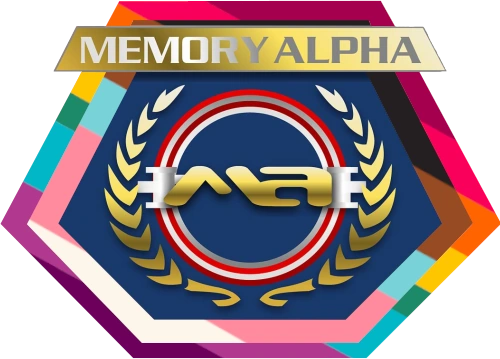"Well, whatever his problems, he certainly came through for us."
Lieutenant Reginald Endicott Barclay III (often referred to as "Reg") was a highly talented Human Starfleet systems diagnostic engineer who lived in the 24th century. In his early days aboard the Enterprise-D, he frequently displayed nervous behavior, demonstrated a noticeable lack of confidence, stammered frequently, was extremely introverted, and occasionally bumbled. These traits aroused the derision of some of his shipmates on the USS Enterprise-D – with some even going as far as calling him "Lieutenant Broccoli" behind his back or, on unfortunate occasions including one involving his commanding officer, Jean-Luc Picard, to his face.
Starfleet career[]
During Barclay's attendance at Starfleet Academy, his "seclusive tendencies" escaped the attentions of neither his classmates nor his service record. Despite this, Barclay graduated and received a commendation by serving competently in Starfleet for many years. During his service aboard the USS Zhukov, he earned satisfactory ratings, and when he transferred to the Enterprise-D the Zhukov's commanding officer, Captain Gleason, spoke highly of Barclay to his new ship's crew. (TNG: "Hollow Pursuits")
The Enterprise-D[]
Upon his transfer to the Enterprise-D in 2366, Barclay held the rank of lieutenant junior grade.
Due to his nervousness and lack of confidence, many members of the Enterprise crew initially referred to him as "Lieutenant Broccoli", a play on his surname, coined by Wesley Crusher. He was initially disliked by members of the crew, not only due to the fact he seemed constantly nervous and on edge, but also because he was routinely late for duty and often wound up on report for seemingly not performing to the best of his ability. As a result, he was given an 'unsatisfactory' rating in his evaluation. Riker and La Forge attempted to get him transferred off the ship, not believing he was competent enough to serve on the Federation flagship (with Riker even suggesting that Captain Gleason had exaggerated his assessment of Barclay to hasten the departure of a troublesome officer). Captain Picard, however, refused to simply transfer him away from the ship, and it was because of Picard's support and Geordi La Forge's encouragement (at Picard's behest) that Barclay's confidence began to increase. (TNG: "Hollow Pursuits")
During the first major Borg incursion into the Federation in late 2366, Barclay worked on repairs with Sherbourne after the Enterprise-D crew, in an unsuccessful attempt to destroy the Borg cube, emitted a burst of energy from their ship's deflector dish. (TNG: "The Best of Both Worlds, Part II")
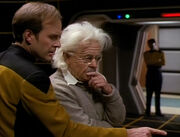
Barclay corrects Albert Einstein
As time passed, Barclay slowly grew in confidence and became one of La Forge's best engineers. Following an encounter with an alien probe in 2367, Barclay's IQ rose to somewhere between 1200 and 1450 as a result of a neurological enhancement he received from the probe. During the time he possessed this enhanced intellect, Barclay was more confident, outgoing, and sure of himself – even arguing grand unified theories with a hologram of Albert Einstein on the holodeck. Barclay was able to use the holodeck to integrate his mind into the ship's computer, effectively taking complete control. Unknown to Barclay, the Cytherians (the creators of the probe) set this in motion so that he would bring the Enterprise-D to them, as this was their species' preferred method of investigating new races. All attempts to disconnect or dissuade him were unsuccessful, and he created a subspace distortion that brought the Enterprise-D to the Cytherians. After this encounter, Barclay was returned to his previous self, but he did retain a bit of the confidence and intelligence that the experience gave him. (TNG: "The Nth Degree")
In 2369, Barclay assisted Alexander Rozhenko with writing a holodeck program of Deadwood, South Dakota in the Ancient West. Barclay included a prostitute and brothel in the simulation (likely forgetting it was to be a child's program), which Lieutenant Worf did not appreciate for his son's sake. (TNG: "A Fistful of Datas")

Barclay speaks with the Moriarty hologram
Later that year, Barclay inadvertently released the holographic representation of Professor James Moriarty from his confines in the computer memory core of the Enterprise-D, while conducting a diagnosis of a failure of the holodeck matrix diodes, which turned out to have been caused by Moriarty himself. Upon activation, Moriarty briefly explained his history to Barclay and, realizing that over four years had passed, deduced that Captain Picard had merely promised to research a way for him to live in the real world in order to get him to release a hostage he had taken at the time. Barclay defended Picard, saying the captain would never go back on his word, and promised to report the incident to his superiors, which he did.
Barclay, Picard, and Data then reactivated the program to speak to Moriarty, who expressed his desire to leave the holodeck. Barclay proposed using transporter pattern enhancers to beam Moriarty off the hologrid and into the "real world." This idea, however, was a ruse by Moriarty to trick the three officers into giving him control of the ship by use of a holographic simulation of the Enterprise-D within the Sherlock Holmes program. The failure of the experiment led Data to discover the trickery, and on Captain Picard's suggestion he and Barclay managed to create a separate simulation within both programs, thereby fooling Moriarty with his own plan. Thinking he was free, Moriarty relinquished control of the Enterprise, allowing Barclay to store his program in an enhancement module, where Morirarty could safely explore the galaxy without causing any further trouble.
Barclay, along with the senior staff, later convened in the observation lounge to discuss recent events, and Captain Picard instructed him to keep the module safe. Picard also jokingly wondered if their reality "might be nothing more than an elaborate simulation being run inside a little device… sitting on someone else's table," which prompted Barclay, after the meeting had concluded, to test the idea by ordering the computer to "end program." Satisfied his life wasn't a simulation when nothing happened, he picked up the module and left as well. (TNG: "Ship In A Bottle")
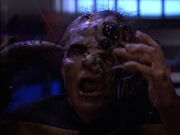
A "devolved" Reginald Barclay
The following year, Barclay had the dubious honor of becoming the eponymous person for a new illness, "Barclay's Protomorphosis Syndrome". He, in common with the rest of the crew, became affected when a treatment for the mild Urodelan flu provided by Doctor Beverly Crusher activated one of Barclay's recessive genes, causing him to mutate into a spider-like creature. It was due only to the efforts of Captain Picard and Lieutenant Commander Data that Barclay and the rest of the crew were saved; as Picard and Data were off the ship when the incident occurred, they were able to develop a retrovirus and release it using the ventilation systems. As Barclay was the first-known patient of the disorder, Dr. Crusher decided to name the newly discovered illness in his honor. (TNG: "Genesis")
In 2375, Lieutenant Commander Worf and Chief O'Brien specifically mentioned that nobody could forget Barclay when remembering old friends on the Enterprise. O'Brien and Worf remembered him most for his extravagant "Three Musketeers" program that he often invited the crew to join him in. (DS9: "Image in the Sand")
Barclay's original Three Musketeers were part of Barclay Program 15, one of the holoprograms that Barclay mass deleted and of which neither O'Brien or Worf ever saw. It seems like he redesigned the Three Musketeers portion in a new program, possibly as an action adventure for users.
Jupiter Station[]
In 2371, the USS Voyager's EMH became trapped in a malfunctioning holodeck programe and encountered a simulation of Barclay, who claimed they were on Jupiter Station and that The Doctor was Dr. Lewis Zimmerman and Barclay was his assistant. At another point, the Doctor believed himself to be in Voyager's sickbay, where a simulation of Harry Kim claimed that Barclay had been assigned to test the The Doctor's interpersonal skills. (VOY: "Projections")
Although the information was only given in a holo program, many details of which turned out not to be true, The Star Trek Encyclopedia (2nd ed. p.33-34) and other references treat Barclay's assignment to Jupiter Station as fact. It is not mentioned in any other episode that he worked on the EMH program, even when the project is discussed in his presence in "Life Line".
Sometime between 2371 and 2376, Barclay was promoted from lieutenant junior grade to lieutenant. (VOY: "Projections", "Pathfinder")
The Enterprise-E[]

Barclay exchanges a handshake with Zefram Cochrane
Barclay was assigned to the new USS Enterprise-E before the Battle of Sector 001 in 2373. He traveled into the past with the rest of the ship's crew to the day before Earth's First Contact with the Vulcans and met the noted inventor Dr. Zefram Cochrane. Barclay was thrilled at the opportunity to shake Cochrane's hand, so much so, in fact, that Lieutenant Commander Geordi La Forge found himself having to remind Barclay to calm down and continue his work, helping Cochrane repair the Phoenix. Barclay also obtained La Forge's approval and input on a makeshift component that Barclay and other engineers from the Enterprise-E intended to use to replace the Phoenix's warp plasma conduit. (Star Trek: First Contact)
The Pathfinder Project[]
In 2374, Barclay was transferred to the Pathfinder Project at Starfleet's Communications Research Center, endeavoring to return Voyager to the Alpha Quadrant from the distant Delta Quadrant. As a result, Barclay relocated to Earth and kept an apartment in San Francisco. Barclay created a holographic recreation of the vessel and its crew to enable him to experiment with different solutions.
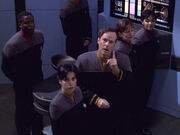
Barclay explains his idea to Admiral Paris
Later that year, Barclay, with the assistance of The Doctor, devised the idea of using the MIDAS array to direct a tachyon beam towards an approaching class B itinerant pulsar, thus generating an artificial micro-wormhole. This wormhole could then be directed towards Voyager's likely locations and used to communicate with the ship. Unfortunately, Commander Pete Harkins turned down his idea as impractical.
However, Barclay was unable to contain his enthusiasm during an inspection of the research facility by Admiral Paris. This prompted Harkins to send Barclay home for the rest of the day. Barclay disobeyed and instead returned to his simulation to refine his ideas. When Harkins later discovered him in the simulation, Barclay was suspended pending a psychological evaluation, as the Commander believed Barclay had suffered a relapse of his holo-addiction.
Barclay was unable to accept this and appealed to Admiral Paris, then broke into the communications center. He attempted to go forward with his plan, but was discovered. To prevent himself from being interrupted, Barclay activated the holographic recreation of Voyager, using the holographic crew to protect and assist him. Just as Harkins used a simulated warp core breach to end the program, Captain Kathryn Janeway hailed the Communications Center from the Delta Quadrant, having received Barclay's message. With this (albeit brief) two-way communication with the ship, ship's logs, research data, a personal message for Tom Paris from his father and instructions in order to improve the communication systems of Voyager were able to be transmitted, and Barclay's ideas were vindicated. The crew of Voyager later toasted their unmet hero who had established the link, honoring Barclay as an honorary member of the crew. (VOY: "Pathfinder")
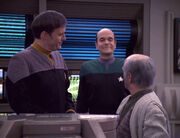
Barclay with Lewis Zimmerman and The Doctor
In 2377, Barclay found a way to use the MIDAS array to transmit a data stream to Voyager once a month, allowing Starfleet to send the crew information and letters from home. He later returned to Jupiter Station with Voyager's EMH, who had been transmitted to the Alpha Quadrant using the connection. Barclay had informed The Doctor that his creator, Doctor Zimmerman, had been diagnosed with acute subcellular degradation and was dying. Although Zimmerman initially refused The Doctor's assistance, Barclay – who had also enlisted the aid of Counselor Deanna Troi – helped The Doctor persuade Zimmerman to realize that The Doctor's assistance was the best course of action to save his life. (VOY: "Life Line")
Later that year, Barclay (possibly inspired by The Doctor's trip to the Alpha Quadrant) attempted to send a hologram to Voyager in order to assist the crew. This failed when the hologram disappeared, costing Voyager's crew that month's data stream. Barclay later discovered that a romantic acquaintance of his, Leosa, had been using him to gain information on Voyager and the Pathfinder project. It turned out the information she had obtained was sold to a group of Ferengi who had used it to alter the holographic program Barclay sent to Voyager, with instructions to kill the crew and reprogram the shields to withstand a geodesic fold they had created between the Alpha and Delta Quadrants. Even though their plan was to steal the Borg technology in Seven of Nine's body (which was worth a fortune in latinum), Barclay, with the help of Counselor Troi, was able to deceive the Ferengi into abandoning their plan, thereby saving Voyager. (VOY: "Inside Man")
In 2378, Barclay created the first-ever transgalactic com link when he used a quantum singularity to establish daily (if brief) real-time contact with Voyager, an incredible achievement. Later he informed Admiral Paris that a draft version of the holonovel Photons Be Free, written by The Doctor, had been released early, becoming popular in thousands of holosuites across the Federation. Barclay was present during a hearing to decide The Doctor's rights as the creator of the work. (VOY: "Author, Author")
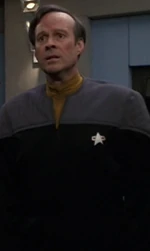
Barclay at the time of Voyager's return
Later that year, Barclay was on duty at the Communications Center when long-range sensors detected a Borg transwarp conduit opening just outside the Sol system. He quickly reported this information to several visiting admirals. When a Borg sphere emerged from the transwarp conduit and exploded to reveal Voyager, Barclay was one of the first to welcome the starship's crew home. (VOY: "Endgame")
Medical and psychological record[]
Barclay suffered from severe transporter phobia, although he later overcame this psychological barrier. (TNG: "Realm Of Fear") He was also hypochondriac and prone to self-diagnosis; once, he thought himself to have transporter psychosis, and on another occasion, he believed himself to have Terellian Death Syndrome (both ultimately untrue). (TNG: "Genesis")
Struggle with holo-addiction[]
The Enterprise-D[]
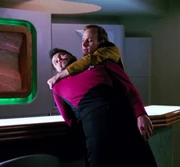
Barclay threatens the Riker hologram
Sometime prior to 2366, Barclay began to suffer from holo-addiction, becoming addicted to the fantasy worlds and stories the holodeck could create. This addiction continued after he transferred to the Enterprise-D, and he had a tendency to spend more time inside the holodeck, where he was more confident and comfortable, than in real-life social situations. Unlike in normal holoprograms, Barclay used the likenesses of the Enterprise's senior staff to create unusual scenarios in which he was the hero.
One of his programs was an exact recreation of the Enterprise-D, in which he often argued with and talked back to senior officers without any fear of consequences. In one holodeck session he propelled the holographic representation of Geordi La Forge across Ten Forward and threatened First Officer William Riker, in an attempt to impress the holographic Deanna Troi.

The "Goddess of Empathy"
Another recreation of Barclay's was entitled "Barclay Program 15". In this scenario, he engaged in sword fights with "The Three Musketeers", holograms that resembled Jean-Luc Picard, Geordi La Forge, and Data; romanced the "Goddess of Empathy", a representation of Deanna Troi; and relaxed with a hologram of Beverly Crusher. Barclay had also created an effigy of William Riker that was an extremely short, bumbling swordsman.
When Barclay's holo-addiction was discovered, Commander Riker was particularly annoyed with him and wanted to delete all programs in which he had used the crew's physical appearances. Counselor Troi objected, as it gave them valuable insight into what was troubling Barclay, but upon seeing the "Goddess of Empathy" she became equally angry (to Riker's amusement; he in turn prevented her from deleting the Goddess for the same reason).
Barclay managed to overcome his addiction with the help of Geordi La Forge. When the Enterprise was in danger of flying herself apart due to an invidium infection of the computer systems, La Forge encouraged Barclay's imagination, and it was he who discovered the infection, which led to the situation being controlled. After a few words from La Forge, Barclay returned to the holodeck and deleted all of his holoprograms but one: Barclay Program 9. The crew soon came to realize he was as important as anyone else on the ship. (TNG: "Hollow Pursuits", "The Nth Degree")
Pathfinder[]
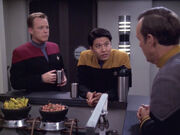
Barclay jokes with a holographic Tom Paris and Harry Kim
In 2376 Barclay became obsessed with attempts to return Voyager from the Delta Quadrant and expressed an interest in becoming involved in the Pathfinder Project. Barclay came dangerously close to suffering a relapse of his holo-addiction later that year, when he used the program that recreated the crew of Voyager. Although it began as a tool to test different theories on how to contact the stranded ship, he quickly came to regard the program as another sanctuary, away from the real world.
The program was only semi-accurate; because of his programming, the duplicates of Voyager's crew all liked and relied upon him, and treated him as their best friend. He joked with Harry Kim, played poker with the senior staff, enjoyed hoverball with Tom Paris, and assisted B'Elanna Torres with warp core calibrations. He even got a massage from The Doctor on one occasion. Barclay once told Deanna Troi that he slept better in his holographic quarters than he ever did in his apartment.
The fascination with Voyager that Barclay had developed, as well as his unauthorized interactions with the holographic crew, expedited his dismissal from the Pathfinder Project. However, once Barclay used the program to prove his theory correct, the time he spent in the Voyager simulation dwindled, along with his need for the holodeck. (VOY: "Pathfinder", "Life Line", "Inside Man", "Author, Author")
Personal life[]
Reginald Barclay was known for his cheese omelets. (VOY: "Pathfinder")
Friendships[]
Geordi La Forge[]
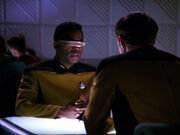
La Forge gets to know Barclay
Geordi La Forge was initially Barclay's superior officer on the Enterprise-D. When he first came aboard, La Forge remarked that Barclay was "always late, never gives his best effort, just slides by." After being instructed by Captain Picard to find a way to integrate him into the crew, however, La Forge began to encourage Barclay and praise him for his efforts.
On the subject of his holo-addiction, La Forge tried to make Barclay feel as though he could interact with the crew and didn't have to confine himself to the holodeck. Barclay once said that he thought La Forge was the most real to him of any of the crew.
Eventually, La Forge came to respect him for his technical knowledge and Barclay became a valued part of the Enterprise engineering crew. (TNG: "Hollow Pursuits")
This cooperation carried over to the Enterprise-E, where Barclay continued to serve under La Forge. When the ship traveled back in time to 2063, Barclay's meeting with Zefram Cochrane was supervised by La Forge. (Star Trek: First Contact)
In February 2377, Barclay attended La Forge's birthday party and showed him the specifications for a hologram he planned to send to the USS Voyager in the Delta Quadrant. La Forge told Barclay he was proud of him. (VOY: "Inside Man")
Lewis Zimmerman[]
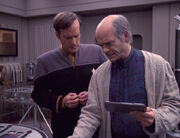
Barclay visits Zimmerman on Jupiter Station
Barclay first met Lewis Zimmerman while working on development of the EMH Mark I in 2371. The two of them later developed a mutual respect, Barclay being instrumental in the forging of Zimmerman's friendship with The Doctor.
When Zimmerman believed he was reaching the end stage of his terminal illness, he included Barclay in his last will and testament, giving him his collection of holographic art including the "Woman in Four Dimensions" piece. In addition, Zimmerman requested that Starfleet allow Barclay to complete his Trojan Horse Project, as he trusted Barclay to be the only engineer that would get it done. (VOY: "Projections", "Life Line")
Deanna Troi[]
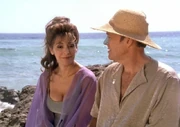
Barclay consults Deanna Troi on his suspicions about Leosa
Barclay met Counselor Troi during his time on the Enterprise-D and quickly developed an attraction to her, even going as far as to use her image in one of his holoprograms, featuring her as his lover. (TNG: "Hollow Pursuits")
Barclay's feelings for her soon became merely professional respect, however, and she continued to provide support to him in the form of counseling and friendship. (ENT: "These Are the Voyages...")
In 2376, at Barclay's request, she visited him to discuss his feelings about his new assignment at Starfleet's Communications Research Center. He opened up to her, noting that work at the CRC was nothing like being on the Enterprise, where there was a feeling of family. (VOY: "Pathfinder")
As a favor to Barclay, Troi asked Captain Jean-Luc Picard for leave from the Enterprise to convince Lewis Zimmerman to accept treatment from Voyager's EMH and assisted Barclay with a ruse to disrupt The Doctor's programming, saying, "Traditional therapy wasn't getting [them] anywhere." (VOY: "Life Line")
In 2377 she again helped Barclay by influencing him to realize that Leosa was using him to gain information on Voyager and encouraged him to report it to his superiors. Troi later invited him on a double date with her, Commander Riker, and a real teacher friend of his called Maril as a way for him to get out and meet people. (VOY: "Inside Man")
The Doctor[]
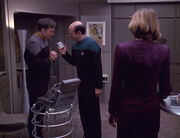
Barclay convinces The Doctor to stay and help Zimmerman
During a severe malfunction, one of The Doctor's recurring delusions was Barclay, who tried to convince him that he was in fact Lewis Zimmerman and that he was trapped in a holographic Voyager. In order to end the simulation, "Lewis" had to destroy the warp core. Fortunately, a delusion of Chakotay convinced him otherwise. The Chakotay hallucination claimed that Barclay was part of the team that created him. (VOY: "Projections")
Barclay first met The Doctor when he took him to Jupiter Station to help Dr. Zimmerman, though the two had previously corresponded via the communication system he developed using the MIDAS array. It was Barclay who had informed The Doctor of Zimmerman's illness, and it was he who initially convinced him to stay and treat Zimmerman, even when he refused all help. (VOY: "Life Line")
When Voyager received the altered Barclay hologram, The Doctor realized something was wrong with the program, stating that the real Barclay never exhibited rude and careless traits as he had observed in the hologram. (VOY: "Inside Man")
During The Doctor's hearing to decide his rights as a hologram Barclay defended him, recounting how he had "traveled halfway across the galaxy" to care for Dr. Zimmerman. He compared it to a son showing his "old man" what he had become so he could be proud of him. When it was ruled that The Doctor had the right to control his own work, Barclay congratulated him. (VOY: "Author, Author")
Pete Harkins[]
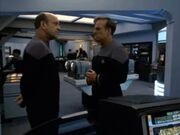
Harkins orders Barclay to take some leave
Commander Pete Harkins was Barclay's superior officer on the Pathfinder Project. He once invited Barclay to dinner with his wife, Angie, and her sister with the aim of setting the sister up with Barclay; refused, preferring to concentrate on his work.
Although he believed Barclay to be a competent engineer, Harkins was skeptical of some of his theories, in part due to Barclay's history. When Barclay developed the idea to use the MIDAS array to create an artificial singularity to Voyager, Harkins dismissed it as a "cock-eyed theory" that only existed in his head and ordered him to abandon the idea. Determined to prove his theory right, Barclay bypassed Harkins and went straight to Admiral Paris. This caused their previous relationship to deteriorate.
Harkins later discovered that Barclay had recreated the Voyager crew on the holodeck. He believed he had been a friend to Barclay by allowing him some leeway, but upon finding him there and realizing his past history of holo-addiction, he pulled him off the project and told him to get counseling.
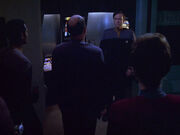
Harkins forces Barclay to end the Voyager simulation
Barclay initially followed Harkins' instructions and went home, where he talked about the situation with Deanna Troi. Later the same night, he decided to disobey Harkins' orders, breaking into the Pathfinder lab and accessing the MIDAS array in an attempt to prove this theory correct. When Harkins discovered Barclay in the lab, he ordered Security to apprehend him, but Barclay activated the Voyager scenario and locked out all holodeck controls. He continued with this plan to send a message to Voyager from within the simulation and used the holographic characters to stop the security officers. Harkins eventually managed to apprehend him by initiating a warp core breach in the simulation, forcing Barclay to close it down.
Harkins then arrested Barclay for breaking into the lab and using equipment without authorization. But before the security officers could take him away, a message came through from Voyager. Barclay's plan had worked. Harkins subsequently apologized for doubting him. (VOY: "Pathfinder")
After Barclay tried to send his hologram to Voyager, he became obsessed with finding the reason why it had failed to reach them, even blaming the Borg and the Romulans for intercepting the message. Harkins ordered him to take a week's leave and return when he was more focused and relaxed. Barclay initially objected to the idea, but Harkins forced the issue, reminding him that he was his superior. He did, however, offer to ask his cousin to allow Barclay to stay in a Malaysian beach house she owned, though Barclay refused, preferring to seek out Deanna Troi's help instead. (VOY: "Inside Man")
Cats[]

Neelix the cat
Barclay had a deep affection for cats, and they returned this affection. Spot, Data's pet cat, found only her owner and the lieutenant to be suitable to her mercurial tastes. (TNG: "Genesis")
Though Barclay had never physically met Neelix, he named his cat after the Talaxian, suggesting at least some level of respect or admiration. He even programmed his simulation of Voyager to have the Talaxian purr. (VOY: "Pathfinder", "Life Line")
Romances[]
Barclay had a series of unsuccessful romantic affiliations, primarily due to his nervous nature. This caused him to focus more on his work than anything else. Despite this, Barclay did begin to pursue a relationship with Hope, the sister-in-law of his superior officer, Pete Harkins, in mid-2376. Their romance did not last very long.
Barclay began to see Leosa by early 2377. When this relationship turned out to be a ruse, Barclay decided not to pursue another relationship. He was then introduced to Maril, a teacher and friend of William Riker, by Deanna Troi. (VOY: "Pathfinder", "Inside Man")
Alternate realities and timelines[]
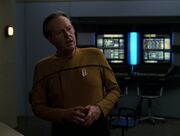
Commander Barclay
In 2404 of an alternate timeline, Barclay managed to stop stuttering (although this affectation resurfaced when he was caught in a lie). He held the rank of commander and became a teacher at Starfleet Academy, teaching a class about the Borg. Barclay later helped Admiral Janeway to travel back in time and return Voyager to Earth sooner than had been done by the vessel's crew. The Doctor learned the truth from him after the addled Tuvok managed to warn him that Janeway was leaving forever. (VOY: "Endgame")
Holograms[]
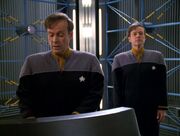
Barclay programming his own hologram
Barclay was holographically duplicated on at least two occasions: In 2371, the USS Voyager encountered a subspace anomaly which caused a feedback surge through The Doctor's holographic matrix, generating a holographic hallucination. Among the projections created was one of Lieutenant Barclay, who insisted the EMH was Doctor Lewis Zimmerman and that Voyager was merely a simulation he had been running at Jupiter Station. Eventually, the crew of Voyager managed to extract The Doctor's program and deactivate the hallucination. (VOY: "Projections")
Barclay created a holographic duplicate of himself to be transmitted to Voyager, where it could aid them in their trip home to Earth. In its first transmission, it was intercepted and reprogrammed as part of a profit scheme devised by three Ferengi, but their plan was ultimately discovered by Barclay himself and the hologram was deactivated. (VOY: "Inside Man")
Memorable quotes[]
"You know, the people that I create in there are m… more real to me than anyone I meet out here. Except… maybe you, commander."
"I need you out here, Reg – now more than ever."
- - Barclay and Geordi La Forge, on his addiction to the holodeck. (TNG: "Hollow Pursuits")
"Mr. Barclay! Everyone's still trying to figure out exactly how you did it."
"Well, it… it just occurred to me that I could set up a frequency harmonic between the deflector and the shield grid, using the warp field generator as a power flow anti-attenuator, and that, of course, naturally created an amplification of the inherent energy output. "
"Uh-huh, I see that…"
- - William Riker and Barclay, after the latter officer increased the Enterprise's shield strength to three hundred percent. (TNG: "The Nth Degree")
"I've lost myself, Deanna."
"Lost yourself?"
"In Voyager. I've become obsessed… with Voyager."
- - Barclay and Deanna Troi, on the Pathfinder Project. (VOY: "Pathfinder")
"Dr. Cochrane, I know this sounds silly, but could I shake your hand? [Cochrane reluctantly shakes it] Oh! Thank you, Doctor! You have no idea what an honor it is to work with you on this project!"
"Reg…"
"I never thought I would ever meet the man who invented warp drive! I.…"
"Reg!"
"Hmm…? Oh! Yes, of course. I'm sorry…"
- - Barclay and Geordi La Forge, after meeting Zefram Cochrane. (Star Trek: First Contact)
"He traveled half-way across the galaxy to care for Lewis Zimmerman, the man who created his program. It was like a son who wanted to show his father what he'd become, so the old man would be proud of him. And if you ask me, he was."
- - Barclay, defending The Doctor as a sentient being. (VOY: "Author, Author")
Appendices[]
Appearances[]
- TNG:
- "Hollow Pursuits" (Season 3)
- "The Nth Degree" (Season 4)
- "Realm Of Fear" (Season 6)
- "Ship In A Bottle" (Season 6)
- "Genesis" (Season 7)
- Star Trek: First Contact
- VOY:
- "Projections" (Only as a hologram) (Season 2)
- "Pathfinder" (Season 6)
- "Life Line" (Season 6)
- "Inside Man" (Season 7)
- "Author, Author" (Season 7)
- "Endgame" (Season 7)
Background information[]
Barclay was played by actor Dwight Schultz.
Origins[]
The character of Barclay was conceived by Gene Roddenberry. "He realized that that type of character was missing from the program," stated Dwight Schultz, "and eventually said, 'Let's fill that spot.'" (TV Zone, issue 139) Schultz believed that, upon inventing the persona, the writing staff were attempting to create a ground-breakingly relatable character. "I think they thought, 'Hey, why don't we write a character who is just like the rest of the Human race and put him on the bridge. I bet our fandom will identify with him.'" (Star Trek Monthly issue 30, p. 32)
The scriptwriter Sally Caves set about creating the character, along with the term "holo-addiction". But when the role of Barclay began to be written, he was described as a contradiction in terms. "But you see, it really has to do with how brilliant he is," noted Dwight Schultz. "Can you overlook his social skills problem to get to his intelligence, his capability?" (Starlog #222)
According to the script for "Hollow Pursuits", the character was originally named "Endicott Reginald Barclay III". However, the first and middle names were later switched for his Star Trek: Starship Creator biography. In the same script's teaser description, Barclay was referred to as "a shy individual with a perpetual frown born of stress and unhappiness between his brows […] What we notice most about him is that he is uncomfortable around other people to the point of agony… he rarely makes eye contact… when he speaks, he hesitates, desperately afraid of saying the wrong thing… which he occasionally does." [1]
Casting[]
When he was cast as Barclay, Dwight Schultz had been a Star Trek fan for a long time and had asked Rick Berman to consider him if the right part came along. (Captains' Logs: The Unauthorized Complete Trek Voyages, p. 196) Whoopi Goldberg was instrumental in arranging for Schultz to play the role of Barclay. "I told her what a big Star Trek fan I was. I asked her what it was like to work with Patrick Stewart […] and she said, 'You gotta be on that show,'" Schultz related. "She went back and told them. Before I knew it, I got a call from my manager asking me if I would like to do it." (Starlog #222)
As a big fan of science fiction and with an interest in science as well as pseudoscience, Dwight Schultz thought it was "perfect" for him to be involved in Star Trek. "I was the lucky one chosen," he remarked. (TV Zone, issue 139) However, the nature of the part came as something of a surprise to Schultz, who at first thought portraying the character would represent a few days' work involving intensive makeup. "I didn't know Barclay was going to be a recurring character," he explained. "As far as I was concerned, it was a one-time shot. I was a little disappointed, to tell you the truth, when I got the script for 'Hollow Pursuits', that my character wasn't a vein-bulging alien." (Star Trek Monthly issue 30, p. 32) Schultz discovered that Barclay, in fact, was closer to his own offstage personality than the actor's most famous role, Captain H.M. ("Howling Mad") Murdock from The A-Team. He was not afraid that accepting the part of Barclay would lead to type-casting. "When we talked about Barclay, you know, the whole concept of him on the Holodeck was that he could be four different characters in one room. He could be something different every time. It doesn't stay that same. It's not a continuation. So, in a sense, you see, there isn't a typing." (Starlog #222)
Portrayals[]
Partly because he was familiar with not only Whoopi Goldberg but also Brent Spiner and Jonathan Frakes as well as several members of the TNG production crew, Dwight Schultz found that making his first guest-star appearance on the show was not an uncomfortable experience. "This was extraordinarily easy for me," he recalled, "because of all the familiar faces […] The script was a terrific Walter Mitty type fantasy. I got to kiss Marina Sirtis and work with Gates McFadden as well as do a bit of sword fighting with Patrick Stewart […] I had a great time." (TV Zone, issue 139)
Soon, plans were made to reprise the character of Barclay. "We put Barclay on our laundry list of things we wanted to bring back fourth season," noted Michael Piller. (Cinefantastique, Vol. 22, No. 2, p. 42) However, finding a way to follow up Barclay's debut was quite challenging, and the TNG writing staff struggled with the issue for around a year. They wanted Barclay to reappear in an episode that had a worthwhile story idea, not just once again portraying the character as a nervous officer on the holodeck. It was Joe Menosky who eventually devised the means by which they would have Barclay make a second appearance. Recalled Piller, "Joe had this concept of somebody who became super intelligent and said, 'Maybe this could be our Barclay show.'" Brannon Braga commented, "It was a good twist on that particular character which you could only get to with a science-fiction gag." Rick Berman contributed to the depiction of Barclay in "The Nth Degree" by suggesting that he play Cyrano De Bergerac in the outing. (Captains' Logs: The Unauthorized Complete Trek Voyages, pp. 218 & 219)
Barclay was considered for one of the junior officers featured in the TNG episode "Lower Decks". "An initial discussion was that Barclay might be involved," recalled Ron Wilkerson, who co-wrote the installment with Jean Louise Matthias, "but we felt pretty strongly we had seen a lot of Barclay already and though he is a strong character, if we put him in this episode, he would overshadow the others." (Cinefantastique, Vol. 25/26, No. 6/1, p. 78) Hence, Barclay's omission from "Lower Decks" was because he was regarded as too well-known. (Star Trek: The Next Generation Companion, 3rd ed., p. 282)
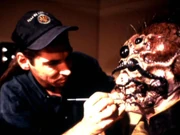
Dwight Schultz's makeup for portraying Barclay as an arachnid is tweaked by Mike Smithson
In Brannon Braga's first draft of "Genesis", virtually all of the Enterprise's crew (with the exception of Data) eventually transformed into Barclay, due to Barclay's Protomorphosis Syndrome. The idea of turning Barclay himself into an arachnid during the course of the installment came easily to Braga. "I just thought it would be fun to make Barclay a spider," Braga stated, "because I can't imagine anything more awful to become. It just seemed natural, since he's a kind of nervous and wiry guy, that maybe he would have had more arachnid ancestors than the other [Enterprise crew members]." (Captains' Logs: The Unauthorized Complete Trek Voyages, pp. 300 & 301) The makeup department was able to create the spider-like creature by using appliances and latex wrinkles applied to the top of Dwight Schultz's head and upper face as well as eye appliances, appliances that looked like spider's eyes, and a spider-leg device that protruded from the side of Barclay's head. (Star Trek: Aliens & Artifacts, p. 118) "To be able to cast all the individual tentacles, the arms that came off of [the spider makeup], to insert all the little eyes into the makeup [took] days to do it." ("The Sky's the Limit, The Eclipse of Star Trek: The Next Generation, Part Two: Penumbra", TNG Season 7 Blu-ray special features) Ronald D. Moore greatly enjoyed "watching Dwight Schultz do his impersonation of a spider running through the obs lounge." (Captains' Logs: The Unauthorized Complete Trek Voyages, p. 301)
René Echevarria felt it "absolutely" would have been fun to send Barclay off with a special final TNG appearance towards the end of the series' seventh season. ("Lower Decks" audio commentary, TNG Season 7 Blu-ray special features)
During early development of Star Trek: Voyager, it was proposed that the holographic main character who ultimately became The Doctor might have the likeness of Barclay and that an episode of Star Trek: The Next Generation's seventh season could feature Barclay working on the hologram. A summary of ongoing development meetings for Voyager, which was written on 6 August 1993, posited, "Barclay would have been working on this program and finally takes a leave to put on the polishing touches (on a TNG episode). He creates the character in his own image." (A Vision of the Future - Star Trek: Voyager, pp. 182 & 183)
Following the appearance of the Barclay hologram in "Projections", the continuation of the real Barclay character was not assured. In a 1996 interview, Dwight Schultz confessed, "I'm almost getting too old to do Barclay, because he's a character who has to change in a different way, or go back, or revert to what he was." (Starlog #222) In an interview from 1997, however, Schultz further contemplated returning as a Star Trek guest star, saying, "Who knows? I could be again someday." (Star Trek Monthly issue 30, p. 37)
Reception[]
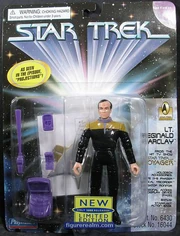
Reginald Barclay action figure (1996)
Dwight Schultz was very thankful for the opportunity to portray Barclay on TNG. (TV Zone, issue 139) "It was actually quite a brilliant stroke that the writers came up with this completely fallible Human being," he said. "They broke new ground with the character. I didn't do it, the writers did it, and I think they knew it." (Star Trek Monthly issue 30, p. 32) Regarding his TNG appearances, Schultz commented, "I've been blessed with some lovely scripts and a character that people could truly identify with." Indeed, the response from Star Trek fans to Barclay was extreme. "They really do identify with Barclay because he has difficulties," Schultz observed. "He's not the super perfect Starfleet Officer you often see in Star Trek, and the audiences love him because of that." (TV Zone, issue 139) Schultz heard many times from Star Trek fans that they very much identified with and related to Barclay. (Star Trek Monthly issue 30, p. 32)
Schultz liked his character but knew Barclay wasn't without his issues. "Barclay had problems, he wasn't perfect; he was someone that the fans I think could identify with. He had a good heart, but he didn't quite fit in all of the time, and I think it brought a unique perspective for the show and for fans. It was a great idea. They finally put an ordinary person on the bridge, and it struck a chord. Barclay sees things that he is not a part of and desperately wants to be there, just as I did for so many years, wanting to be an actor! He desperately wants to be things that he's not and will never be – he will probably always be a lieutenant, but he has a great heart. I think he recognises that it's very important to fulfill your place, more so than it is to move beyond it, and he was given this very, very sweet disposition by the writers; and I think that sums him up. A great heart, and recognises his place, but he's a Walter Mitty dreamer. It's one of those things that I have been thinking about for a long time. I think Barclay would desperately like to be promoted, yet he has good understanding as to why he would not be. He would be in electronic research of some kind. No question. The computer nerd of the future is what he would be, without doubt! He would be buried in quantum fields and the study of particle accelerators and attempting to divine super warp drives, that sort of thing. It lets you realize first of all, this is all fantasy anyway [and] that there is a place for everyone in the future, even this idealized future that Star Trek represents as opposed to the darker future that Babylon 5 presented. It's very good for the fans to have an ordinary person there, just a regular guy who sometimes is going to make mistakes." (Star Trek Magazine issue 113), [2](X)
The popularity of the character with Star Trek fans led to Barclay's reappearances following his introduction in "Hollow Pursuits". (Star Trek Monthly issue 30, p. 32) Many fans responded positively to how he was depicted in "The Nth Degree", which Dwight Schultz cited as his favorite episode, partly due to what happens to the character therein (but also because Schultz approved of the possible future for Humanity which that installment suggests). (Starlog #222)
Michael Piller remarked, "[Barclay] is a very interesting character and a great actor." (Captains' Logs: The Unauthorized Complete Trek Voyages, p. 218)
Playmates Toys have released two action figures based on Reginald Barclay; the first, in 1994, was based on his appearances throughout Star Trek: The Next Generation and the second, in 1996, was based on his appearance in the Star Trek: Voyager episode "Projections".
Barclay's behaviour has been interpreted as social anxiety disorder and imposter syndrome. [3]
Apocrypha[]
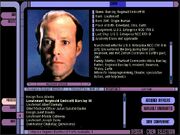
Personnel file for Reginald Barclay in Star Trek: Starship Creator
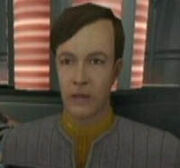
Lieutenant Barclay in Elite Force II
Barclay appears as a selectable crew member in the non-canon video game Star Trek: Starship Creator, in which his personnel file states he was born in 2340 in Cleveland, Ohio and gained a Master's Degree in Computer Systems from the Daystrom Institute in 2362. It explains he did not attend Starfleet Academy and was instead offered a commission by Starfleet at the rank of lieutenant junior grade, which he accepted. It further states that Barclay's interests were holoprogramming, theater, speculative fiction, and self-help books, and that his father was Reginald Barclay II and his mother was Commander Alicia Barclay, both of whom resided in Swansea, Wales.
In Peter David's novel Imzadi, Barclay is involuntarily cured of his holo-addiction in 2368 when an aged Admiral Riker, having used the Guardian of Forever to travel back in time and prevent the death of Counselor Troi, materializes in the past on the holodeck during one of Barclay's adventures. Disguising his presence by claiming to be an automatic system programmed to activate if Barclay used his holoprograms again, Admiral Riker instructs Barclay to shut the program down. Barclay is so intimidated by the admiral that he decides never to use the holodeck again. This is inconsistent, however, with the Voyager story line.
In Michael Jan Friedman's novel Crossover, Barclay transferred back to the Enterprise-D in 2371 when Admiral Leonard McCoy came aboard and wrested command from, and subsequently relinquished command to Captain Picard. Picard soon after took the ship into Romulan space on a rescue mission to retrieve his senior officers, who had been captured in a failed attempt to retrieve Captain Montgomery Scott, who had, in turn, been captured in a failed attempt to retrieve Ambassador Spock.
In Greg Cox's The Q Continuum trilogy, Barclay discovers that the bio-neural gel packs used in the USS Enterprise-E are capable of absorbing the psionic energy of the galactic barrier, prompting him to suggest that the crew channel the resulting energy into the Enterprise's shields so that they can increase the time that they can remain in the barrier during an attempt to hide from the Calamarain.
In Diane Duane's novel Dark Mirror, Lieutenant Commander Barclay is Captain Picard's chief bodyguard in the mirror universe. While masquerading as his mirror universe counterpart, Picard notes that Barclay's "slightly crazed creativity" has been redirected, replacing his quirkiness with a more hard-edged sense of danger. Picard promises Mirror Barclay a promotion, but he is killed before this can happen. Upon returning to his own universe, Picard achieves a sort of symmetry by noting a special commendation on the "real" Barclay's record as a reward for the extra work he has been putting in.
In the Strange New Worlds short story The Naked Truth, which is set in 2370, Captain Picard orders Barclay to lead his first away mission, installing a new generator core in a space station in the Tarvo system. However, Barclay and his team soon end up fighting for their lives in a Vorel trap.
Barclay also appears in the John Vornholt novels Gemworld, Book One and Book Two, as a crewmember on the Enterprise-E in 2375 shortly after the end of the Dominion War where he helped deal with the Gemworld Crisis.
In the video game Star Trek: Elite Force II, set in 2380, Barclay serves as temporary chief engineer on the Enterprise-E.
In the Kirsten Beyer novel Full Circle, Barclay is assigned to the USS Galen, which has been fitted with a quantum slipstream drive and assigned to Project Full Circle, an expeditionary force sent to explore the Delta Quadrant. The novel takes place in the year 2381.
In the David A. McIntee novel Indistinguishable from Magic, set in 2383, Barclay was involved in a transporter project designed to transport a living person over long distances via the Pathfinder Project. He held the record for longest distance transport when Montgomery Scott ordered that Barclay be reassigned to the Starfleet Corps of Engineers USS Challenger as a mission specialist during the investigation of the derelict Intrepid NX-07. After the vessel was hijacked by Berlinghoff Rasmussen and former DaiMon Bok, Barclay was instrumental in returning the crew to the Challenger. When his friend Geordi La Forge was named captain of the Challenger following Captain Scott's retirement, Barclay agreed to remain aboard as chief of operations. During his first mission as chief of operations, the Challenger investigated a new form of technology known as Trans-slipstream and was transported to NGC-4414 along with the rescued crew of the IRW Stormcrow. Teamed with Romulan engineer Voktra (of whom he developed a romantic interest), the two worked to find a way to escape from the region and participated in an away mission to the derelict USS Hera. Following the destruction of the Challenger in order for the crew to return home, Barclay returned to Jupiter Station where he expected to be returned to the Voyager fleet in the Delta Quadrant. He also had proposed to Starfleet an increased Romulan presence in exploration missions, which Voktra also proposed to her government.
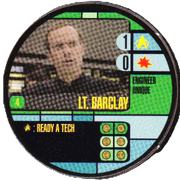
Lt. Barclay, Star Trek: Red Alert! by Last Unicorn Games.
Lt. Barclay is a playable character in the Customizable Disc Game Star Trek: Red Alert! by Last Unicorn Games.
External links[]
- Reginald Barclay at Memory Beta, the wiki for licensed Star Trek works
- Reginald Barclay at Wikipedia

